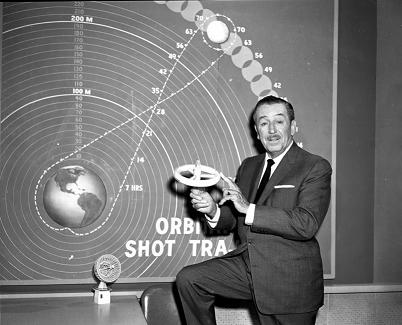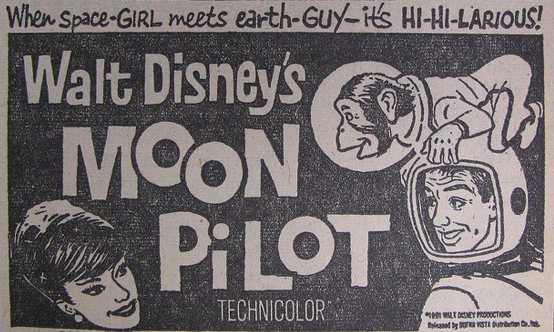
“A funny thing happened to me on my way to the moon…girl (with seven moons all made for love) meets boy (with chimp)…and WOW!”
That was the marketing phrase that appeared on many movie advertisements for the Disney live-action “Technicolor® blast of fun and entertainment” known as Moon Pilot, first released to theaters nearly fifty years ago.
Captain Richmond Talbot
Astronaut Captain Richmond Talbot (played by ruggedly handsome Tom Tryon) accidentally “volunteers” to make the first manned flight around the moon. However, during a visit home to see his mother and brother before the blast-off, he meets a strange young woman named Lyrae (played by petite French actress Dany Saval) who mysteriously knows all about his secret mission, and has some vital information she is desperate to share. Is she a foreign spy? All of the resources of the Federal Security Agency can’t keep these two young people apart while the success of this historic space flight is held in the balance.
Daily Variety Review
In its review of the film on January 15, 1962, the entertainment trade newspaper Daily Variety praised the lighthearted production with statements like, “Filmgoers in general will accept this picture as light, gay, infectious diversion. The upshot, at any rate appears to be another moneymaker for Disney…and additional bow to co-producer Bill Anderson and associate (producer) Ron Miller for a job well done.”
American Backlash
However, the American audience was not in the mood for a playful look at outer space. There was a lot of tension because of a very serious “Space Race” between the United States and the Soviets. Soviet cosmonaut Yuri Gargarin had been the first man to be launched into orbit in April 1961. While American astronaut Alan Shepard would be shot into space in May 1961, he did not orbit the Earth. That honor would go to American astronaut John Glenn in February 1962.
Based on Real Space Gear
Disney supported the US in several ways throughout the war. One of the biggest was creating films that incorporated war time propaganda. The battle for the supermacy of outer space made it extremely difficult for the Disney designers to get access to necessary information. Walt wanted a sense of reality for his fantasy, so he visited the Vandenberg Air Force Base to see the launching of an Atlas missile for himself and to gather information about the design of the interior of the blockhouse.
The most difficult item to create was the space capsule itself (seen in the opening segment of the film), because all such information was highly classified. The Air Force also furnished a Technical Director, made some stock footage available, furnished air craft for a scene or two, and allowed some limited shooting on the base.
The Original Story
The original story was written by Robert Buckner (a screenwriter for such films as Yankee Doodle Dandy and Knute Rockne, All American) and published in Spring 1960 as a three-part serial for The Saturday Evening Post. In December of that year, it was published in paperback book form as Starfire, the name of the space capsule.
Screenwriter Maurice Tombragel- who had written for Disney’s TV program Elfego Baca and would later write the Disney screenplay for Monkeys, Go Home! (1967)- adapted Buckner’s story, but kept very close to the original storyline, even using some of the dialogue Buckner had written.
James Nielson (who would later direct Disney classics like Summer Magic (1963) and Dr. Syn, Alias the Scarecrow (1963)) was brought on to direct his first Disney feature film.
The Famous Tom
Tom Tryon had been appearing in the title role of Texas John Slaughter on the weekly Disney television show. The series ran for 17 hour-long episodes from 1958–61, and according to the Disney publicity department “Tryon’s fan following reached a record high, and he became a new hero of America’s TV viewers.” Tryon later left acting and became a bestselling novelist with the release of his psychological horror novel The Other in 1971.
The Mysterious Girl
Walt Disney felt he needed a good actress to portray the mysterious girl from outer space in Moon Pilot, but one that no one knew in America, in order to maintain an elusive quality to the character. According to the press book for the film, Walt “personally supervised an exhaustive talent hunt for ‘Lyrae’ that spanned all of America and most of Western Europe. The noted producer and his staff viewed literally thousands of feet of film, and interviewed scores of potential ‘planet girl’ candidates at the Disney Studios.”
Eventually, they selected nineteen-year-old Dany Saval who had appeared in eight French language films. For her audition, she had to learn the words in the script phonetically since her English was extremely limited. After one more American film, she married composer Maurice Jarre and returned to France.
The Start for Sally Field
The film also marked the screen debut of a young actress whose part is so small that she is not even listed in the credits. When the Federal Security Agency rounds up some female beatniks in San Francisco as they search for Talbot’s mysterious femme fatale, the one in the oversized sweater, dark hair and glasses is Oscar®-winning actress Sally Field spouting one of three songs written by the legendary Sherman brothers.
The Music of Moon Pilot
The Sherman brothers had just finished work on their first Disney film, The Parent Trap (1961) producing Hayley Mills’ hit single “Let’s Get Together” when Walt pulled them in to work their musical magic for Moon Pilot. Disney hoped for a huge success with the discovery of the young Dany Saval and had the Sherman brothers write her a song entitled “The Seven Moons of Beta Lyrae” that was quickly forgotten.
The brothers also produced two “senseless songs of satire” (as the pressbook described them) for the beatniks: “True Love is an Apricot” and “The Void,” neither of which were showcased properly for either comedic effect or enjoyment of the clever writing.

Some Unhappy Audiences
One person who was not a fan of the film was the Director of the FBI, J. Edgar Hoover. He had read the original Buckner story, and was unhappy that it had made fun of FBI agents as bumblers and “UFO nuts.” He asked his Los Angeles agents to talk with Walt personally and convince him that the FBI would not be put in charge of guarding an Air Force pilot. Walt relented, and replaced the FBI Agent with the generic “Federal Security Agency.” Audiences and critics weren’t fooled a bit.
Amusingly, one of the newspaper advertisements (displayed in the official 1962 pressbook) had cartoon caricatures of Edmond O’Brien, Brian Keith, and Tom Tryon all in space helmets straddling a flying rocket ship pursuing a floating cartoon caricature of Dany Saval.
The text for the advertisement was: “The FBI thought she was a SPY!…The General thought she was a KOOK!…The Astronaut thought she was OUT-OF-THIS-WORLD!...and she was OUT-OF-THIS-WORLD! (She’s from a planet that has 7 moons…all made for LOVE!)” Yep, that advertisement, clearly indicating the bumbling character played by O’Brien was from the FBI, appeared in newspapers around the country.
Visit Us and Learn More About Disney’s Amazing History
Originally constructed in 1897 as an Army barracks, our iconic building transformed into The Walt Disney Family Museum more than a century later, and today houses some of the most interesting and fun museum exhibitions in the US. Explore the life story of the man behind the brand—Walt Disney. You’ll love the iconic Golden Gate Bridge views and our interactive exhibitions here in San Francisco. You can learn more about visiting us here.
Images above: Walt introduces the first TV airing of Moon Pilot, January 16, 1966. © Disney 2) Advertisement for Moon Pilot.
JIM KORKIS is an internationally-respected Disney Historian who has written hundreds of article and done hundreds of presentations on all things Disney for more than thirty years. At 3:00pm on Saturday, July 23, Jim will host Walt’s Fascination with Outer Space, focusing on Walt as a visionary and futurist, his interest with space, how he helped build support for the U.S. Space Program, and his scientific and cultural contributions. Tickets are available at the Reception and Member Service Desk at the museum, or online at www.waltdisney.org.
